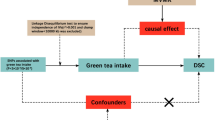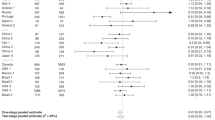Abstract
Purpose
Green tea may have a beneficial role of inhibiting leukemia. Glutathione S-transferases (GSTs) are known to detoxify certain carcinogens. We investigated the roles of green tea consumption and polymorphisms of GSTM1, GSTT1 and GSTP1 on the risk of adult leukemia, and to determine whether the associations varied within GSTs genotypes.
Methods
A multicenter case–control study was conducted in China, 2008–2013. It comprised 442 incident, hematologically confirmed adult leukemia cases and 442 outpatient controls, individually matched to cases by gender, birth quinquennium and study site. Data were collected by face-to-face interview using a validated questionnaire. Genetic polymorphisms were assayed by PCR.
Results
An inverse association between green tea consumption and adult leukemia risk was observed. Compared with non-tea drinkers, the adjusted odds ratios (95 % confidence intervals) were 0.50 (0.27–0.93), 0.31 (0.17–0.55) and 0.53 (0.29–0.99) for those who, respectively, consumed green tea >20 years, ≥2 cups daily and dried tea leaves >1000 g annually. In assessing the associations by GSTs genotypes, risk reduction associated with green tea consumption was stronger in individuals with the GSTT1-null genotype (OR 0.24; 95 % CI 0.11–0.53) than GSTT1-normal carriers (OR 0.67; 95 % CI 0.42–1.05; P interaction = 0.02). GSTM1 and GSTP1 did not significantly modify the inverse association of leukemia with green tea.
Conclusions
The results suggest that regular daily green tea consumption may reduce leukemia risk in Chinese adults regardless of GSTM1 and GSTP1 polymorphic status. The association between green tea and adult leukemia risk varied with GSTT1 genotype and highlights further study.
Similar content being viewed by others
References
Inaba H, Greaves M, Mullighan CG (2013) Acute lymphoblastic leukaemia. Lancet 381:1943–1955
Strange RC, Fryer AA (1999) The glutathione S-transferases: influence of polymorphism on cancer susceptibility. In: Vineis P, Malats N, Lang M, d’Errico A, Caporaso N, Cuzick J, Boffetta P (eds) Metabolic polymorphisms and susceptibility to cancer. IARC Scientific Publications, Lyon, pp 231–249
He HR, You HS, Sun JY, Hu SS, Ma Y, Dong YL, Lu J (2014) Glutathione S-transferase gene polymorphisms and susceptibility to acute myeloid leukemia: meta-analyses. Jpn J Clin Oncol 44:1070–1081
He HR, Zhang XX, Sun JY, Hu SS, Ma Y, Dong YL, Lu J (2014) Glutathione S-transferase gene polymorphisms and susceptibility to chronic myeloid leukemia. Tumour Biol 35:6119–6125
Graham HN (1992) Green tea composition, consumption, and polyphenol chemistry. Prev Med 21:334–350
Sonoda J, Koriyama C, Yamamoto S, Kozako T, Li HC, Lema C, Yashiki S, Fujiyoshi T, Yoshinaga M, Nagata Y, Akiba S, Takezaki T, Yamada K, Sonoda S (2004) HTLV-1 provirus load in peripheral blood lymphocytes of HTLV-1 carriers is diminished by green tea drinking. Cancer Sci 95:596–601
Britschgi A, Simon HU, Tobler A, Fey MF, Tschan MP (2010) Epigallocatechin-3-gallate induces cell death in acute myeloid leukaemia cells and supports all-trans retinoic acid-induced neutrophil differentiation via death-associated protein kinase 2. Br J Haematol 149:55–64
Ly BT, Chi HT, Yamagishi M, Kano Y, Hara Y, Nakano K, Sato Y, Watanabe T (2013) Inhibition of FLT3 expression by green tea catechins in FLT3 mutated-AML cells. PLoS ONE 8:e66378
Iwasaki R, Ito K, Ishida T, Hamanoue M, Adachi S, Watanabe T, Sato Y (2009) Catechin, green tea component, causes caspase-independent necrosis-like cell death in chronic myelogenous leukemia. Cancer Sci 100:349–356
Lee YK, Bone ND, Strege AK, Shanafelt TD, Jelinek DF, Kay NE (2004) VEGF receptor phosphorylation status and apoptosis is modulated by a green tea component, epigallocatechin-3-gallate (EGCG), in B-cell chronic lymphocytic leukemia. Blood 104:788–794
Zhang M, Zhao X, Zhang X, Holman CD (2008) Possible protective effect of green tea intake on risk of adult leukaemia. Br J Cancer 98:168–170
Kuo YC, Yu CL, Liu CY, Wang SF, Pan PC, Wu MT, Ho CK, Lo YS, Li Y, Christiani DC (2009) A population-based, case–control study of green tea consumption and leukemia risk in southwestern Taiwan. Cancer Causes Control 20:57–65
Gao CM, Takezaki T, Wu JZ, Li ZY, Liu YT, Li SP, Ding JH, Su P, Hu X, Xu TL, Sugimura H, Tajima K (2002) Glutathione-S-transferases M1 (GSTM1) and GSTT1 genotype, smoking, consumption of alcohol and tea and risk of esophageal and stomach cancers: a case–control study of a high-incidence area in Jiangsu Province, China. Cancer Lett 188:95–102
Mu LN, Lu QY, Yu SZ, Jiang QW, Cao W, You NC, Setiawan VW, Zhou XF, Ding BG, Wang RH, Zhao J, Cai L, Rao JY, Heber D, Zhang ZF (2005) Green tea drinking and multigenetic index on the risk of stomach cancer in a Chinese population. Int J Cancer 116:972–983
Bonner MR, Rothman N, Mumford JL, He X, Shen M, Welch R, Yeager M, Chanock S, Caporaso N, Lan Q (2005) Green tea consumption, genetic susceptibility, PAH-rich smoky coal, and the risk of lung cancer. Mutat Res 582:53–60
Liu P, Holman CD, Jin J, Zhang M (2015) Diet and risk of adult leukemia: a multicenter case–control study in China. Cancer Causes Control 26:1141–1151
Zhang ZN, Shen D (2007) The standards of diagnosis and treatment in haematology, 3rd edn. Science Press, Beijing
Zhang M, Binns CW, Lee AH (2002) Tea consumption and ovarian cancer risk: a case–control study in China. Cancer Epidemiol Biomarkers Prev 11:713–718
Zhang M, Binns CW, Lee AH (2005) A quantitative food frequency questionnaire for women in southeast China: development and reproducibility. Asia Pac J Public Health 17:29–35
Jian L, Binns CW, Lee AH (2006) Validity of a food-frequency questionnaire for elderly men in southeast China. Public Health Nutr 9:928–933
Funke S, Timofeeva M, Risch A, Hoffmeister M, Stegmaier C, Seiler CM, Brenner H, Chang-Claude J (2010) Genetic polymorphisms in GST genes and survival of colorectal cancer patients treated with chemotherapy. Pharmacogenomics 11:33–41
Harries LW, Stubbins MJ, Forman D, Howard GC, Wolf CR (1997) Identification of genetic polymorphisms at the glutathione S-transferase Pi locus and association with susceptibility to bladder, testicular and prostate cancer. Carcinogenesis 18:641–644
Breslow NE, Day NE (1980) Volume 1—the analysis of case–control studies. In: Davis W (ed) Statistical method in cancer research. IARC Scientific Publications, Lyon, pp 162–191
Rothman KJ, Greenland S, Lash TL (2008) Modern epidemiology, 3rd edn. Lippincott Williams & Wilkins, Philadelphia
Rota M, Porta L, Pelucchi C, Negri E, Bagnardi V, Bellocco R, Corrao G, Boffetta P, La Vecchia C (2014) Alcohol drinking and risk of leukemia—a systematic review and meta-analysis of the dose–risk relation. Cancer Epidemiol 38:339–345
Nakagawa H, Hasumi K, Woo JT, Nagai K, Wachi M (2004) Generation of hydrogen peroxide primarily contributes to the induction of Fe(II)-dependent apoptosis in Jurkat cells by (−)-epigallocatechin gallate. Carcinogenesis 25:1567–1574
Berletch JB, Liu C, Love WK, Andrews LG, Katiyar SK, Tollefsbol TO (2008) Epigenetic and genetic mechanisms contribute to telomerase inhibition by EGCG. J Cell Biochem 103:509–519
Rollinson S, Roddam P, Kane E, Roman E, Cartwright R, Jack A, Morgan GJ (2000) Polymorphic variation within the glutathione S-transferase genes and risk of adult acute leukaemia. Carcinogenesis 21:43–47
Norppa H, Hirvonen A, Jarventaus H, Uuskula M, Tasa G, Ojajarvi A, Sorsa M (1995) Role of GSTT1 and GSTM1 genotypes in determining individual sensitivity to sister chromatid exchange induction by diepoxybutane in cultured human lymphocytes. Carcinogenesis 16:1261–1264
Landi S, Ponzanelli I, Hirvonen A, Norppa H, Barale R (1996) Repeated analysis of sister chromatid exchange induction by diepoxybutane in cultured human lymphocytes: effect of glutathione S-transferase T1 and M1 genotype. Mutat Res 351:79–85
Li L, Zhang M, Holman D (2011) Population versus hospital controls for case–control studies on cancers in Chinese hospitals. BMC Med Res Methodol 11:167
Li L, Zhang M, Holman CD (2013) Population versus hospital controls in the assessment of dietary intake of isoflavone for case–control studies on cancers in China. Nutr Cancer 65:390–397
Li L, Zhang M, Holman CD (2013) Hospital outpatients are satisfactory for case–control studies on cancer and diet in China: a comparison of population versus hospital controls. Asian Pac J Cancer Prev 14:2723–2729
International Agency for Research on Cancer (2012) IARC monographs on the evaluation of carcinogenic risks to humans. Benzene. In: Chemical agents and related occupations, vol 100F. WHO, Lyon
International Agency for Research on Cancer (2001) IARC monographs on the evaluation of carcinogenic risks to humans. Ionizing radiation. In: Some internally deposited radionuclides, vol 78. WHO, Lyon
Acknowledgments
The authors are grateful to the participants in this study for their cooperation. The authors would also like to thank the staff from the three participating hospitals and Zhejiang University Women’s Hospital for their kind assistance with fieldwork. The first author was supported by the Scholarship for International Research Fees and the University Postgraduate Award of The University of Western Australia.
Funding
This work was funded by the National Health and Medical Research Council (Australia) Project Grant (Grant Number 572542).
Author information
Authors and Affiliations
Corresponding author
Ethics declarations
Conflict of interest
None declared.
Rights and permissions
About this article
Cite this article
Liu, P., Zhang, M., Xie, X. et al. Green tea consumption and glutathione S-transferases genetic polymorphisms on the risk of adult leukemia. Eur J Nutr 56, 603–612 (2017). https://doi.org/10.1007/s00394-015-1104-x
Received:
Accepted:
Published:
Issue Date:
DOI: https://doi.org/10.1007/s00394-015-1104-x




